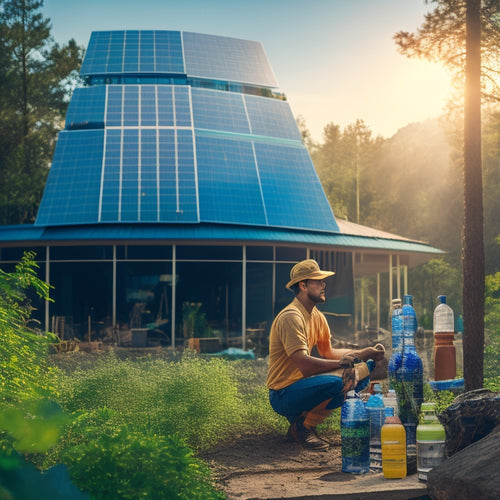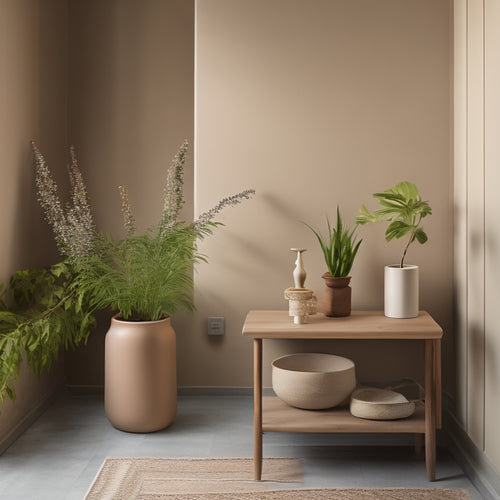
5 Tips: Automated Shades for Sustainable Home Energy
Share
You're taking a significant step towards creating a sustainable home by leveraging automated shades to reduce your energy consumption and carbon footprint. To maximize natural light harvesting, consider strategic window placement and integrate renewable energy sources. Optimize energy consumption patterns by adjusting shades for natural light during the day and closing them during peak energy usage periods. Automate shading to synchronize with your energy usage patterns, and select eco-friendly shade materials with high thermal insulation. By integrating your shades with smart home systems, you'll enhance your living experience and achieve seamless control – and that's just the beginning of your sustainable home energy expedition.
Key Takeaways
- Maximize natural light harvesting by strategically placing windows and skylights during the design phase to reduce reliance on artificial lighting.
- Optimize energy consumption patterns by automating shades to reduce the need for artificial lighting and HVAC systems during daylight hours.
- Select the right shade materials with high thermal insulation and eco-friendly options to minimize environmental impact and maximize energy efficiency.
- Integrate automated shades with smart home systems for seamless control and centralized management of energy consumption and living comfort.
- Program automated shades to close during peak energy usage periods and open during winter for passive heating to further reduce energy consumption.
Maximize Natural Light Harvesting
As you design your sustainable home, maximizing natural light harvesting is essential to reducing your reliance on artificial lighting and minimizing energy consumption.
You'll want to take into account light diffusion and solar angles to optimize the amount of natural light entering your space. By strategically placing windows and skylights, you can utilize natural light during peak hours, reducing the need for artificial lighting.
Furthermore, incorporating renewable energy sources like solar power for your home can further reduce your carbon footprint.
Additionally, automated shades can help regulate light diffusion, allowing you to control the amount of light entering your home.
Optimize Energy Consumption Patterns
With automated shades integrated into your sustainable home, you're not only utilizing natural light but also ready to optimize your energy consumption patterns. By doing so, you'll reduce your reliance on artificial lighting and HVAC systems, resulting in significant energy savings.
Adjust your automated shades to allow natural light during daylight hours, reducing the need for artificial lighting. Additionally, consider incorporating renewable energy sources like solar or wind power to further minimize your carbon footprint.
Program your shades to close during peak energy usage periods, minimizing heat gain and reducing the load on your HVAC system. Use your automated shades to block direct sunlight during hot summer months, reducing cooling costs.
Take advantage of passive heating during winter by opening your shades to let natural light warm your home.
Automate Shading for Energy Savings
By synchronizing your automated shades with your home's energy usage patterns, you can maximize energy savings and reduce your environmental impact. This harmonization allows for ideal solar control, reducing the need for artificial lighting during the day.
To further enhance energy production, consider optimizing your solar panel array design, including strategic orientation, proper tilt, and array sizing to meet your energy needs. As a result, you'll decrease your energy consumption and lower your energy bills.
Effective daylight management also helps regulate the temperature in your home, reducing the load on your HVAC system. By automating your shading system, you'll guarantee that your home is always fine-tuned for energy efficiency, giving you the freedom to live life on your own terms while minimizing your carbon footprint.
Selecting the Right Shade Materials
You've optimized your automated shading system to maximize energy savings, and now it's time to focus on the materials that will make it all come together.
The right shade materials can greatly impact your system's performance and environmental impact. When selecting fabrics, consider the following factors:
-
Fabric types: Choose from a variety of materials, such as solar screens, light-blocking fabrics, or decorative shades, depending on your desired level of light control and aesthetic.
-
Opacity and transparency: Select fabrics with varying levels of opacity to control the amount of natural light entering your home. By incorporating eco-friendly materials, you can reduce your carbon footprint, much like solar EV charging stations reduce reliance on fossil fuels.
-
Thermal performance: Opt for materials with high thermal insulation to reduce heat gain during summer and heat loss during winter, which can lead to lower operating costs and a more sustainable future.
- Sustainability: Consider eco-friendly fabric options made from recycled materials or with low environmental impact.
Integrating With Smart Home Systems
Frequently, homeowners find that integrating their automated shading system with their smart home setup can greatly enhance their overall living experience. This integration allows you to control your shades seamlessly from a single user interface, creating a more comfortable and energy-efficient living space. When selecting an automated shading system, consider smart home compatibility to guarantee a smooth integration process.
| Smart Home System | Automation Hub | User Interface Design |
|---|---|---|
| Amazon Alexa | Samsung SmartThings | Voice Command |
| Apple HomeKit | Wink Hub | Touchscreen Display |
| Google Home | Control4 | Mobile App |
Frequently Asked Questions
Can I Install Automated Shades in Rental Properties?
You'll need to check your rental agreement before installing automated shades, as it may require landlord approval or have specific guidelines. Be prepared to address potential installation challenges, such as wiring or bracketing, to guarantee a smooth process.
Are Automated Shades Compatible With All Window Types?
You wonder if automated shades will fit your unique windows, but fear not - most window treatments can accommodate them, ensuring energy efficiency and freedom from manual adjustments, with some exceptions for extremely large or irregularly shaped windows.
Do Automated Shades Require Regular Maintenance?
You'll be relieved to know that automated shades require minimal maintenance, ensuring their longevity. Typically, you'll need to dust them every 3-6 months and replace batteries every 3-5 years, depending on usage, to keep them running smoothly and efficiently.
Can I Control Automated Shades With Voice Commands?
Voice control, your new superpower! You can indeed control automated shades with voice commands, thanks to smart home integration, effortlessly optimizing energy efficiency and freeing you to focus on what matters most.
Are There Any Rebates or Incentives for Automated Shade Installations?
You'll be happy to know that yes, there are rebates and incentives available for automated shade installations, which can help offset installation costs and maximize energy savings, giving you the freedom to enjoy a more sustainable home.
Related Posts
-

What Tax Deductions Apply to Sustainable Building Materials?
You can claim various tax deductions for sustainable building materials, thanks to over 40 federal tax incentives sup...
-

Why Biodegradable Dish Soap Matters for Earth-Conscious Homes
You likely don't realize that the dish soap you're using today will still be harming the environment long after you'v...
-

What Are Natural Clay Paints for Green Home Interiors?
You're about to uncover a game-changing alternative to synthetic paints that not only enhances the aesthetic of your ...


